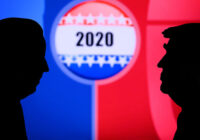The New Yorker features a lengthy biographical portrait of Democratic presidential nominee Joe Biden written by Evan Osnos. Clearly recognizing Biden’s positioning on the electoral spectrum, the title of the article takes the form of a question: “Can Biden’s Center Hold?” Though it doesn’t provide an answer to the question, it implicitly pleads in favor of Biden’s tactical choice of occupying the center, not just of the Democratic Party but of the entire oligarchic system.
Can the Dollar Continue to Dominate in a Changed World?
Osnos focuses on the candidate’s own characterization of his strategy. “Biden has described himself as a ‘transition candidate,’ able to overcome generational and ideological rifts,” he writes.
Here is today’s 3D definition:
Transition candidate:
A candidate lacking definition in terms of vision or coherent policy agenda, but intent upon influencing the choice of future leaders, presumably who will share the same deficiency of vision and clarity
Contextual Note
Osnos zeroes in on Biden’s idea of what it means to ensure a transition. He writes: “In the spring, Biden began describing himself as a ‘transition candidate,’ explaining, ‘We have not given a bench to younger people in the Party, the opportunity to have the focus and be in focus for the rest of the country. There’s an incredible group of talented, newer, younger people.’”
We might marvel at the tautology offered by a 77-year-old man, whose political career spans more than 50 years, referring to people who are at the same time “newer” and “younger.” The two attributes tend to go together. But Biden undoubtedly remembers that his opponent, US President Donald Trump, was new to politics at the age of 69 when he launched his first real political campaign in 2015.
Biden is also correct in noticing the rise of a generation of newer, younger people who have been making headlines, such as “the squad,” led by Representatives Alexandria Ocasio-Cortez (AOC) and Ilhan Omar. They are now being joined by a host of new candidates for this election, some of whom have successfully unseated longstanding incumbents, such as Cori Bush, who defeated the William Lacy Clay dynasty in Missouri, or Jamal Bowman, who upended the career of Eliot Engel, chairman the House Foreign Affairs Committee.
But those aren’t the youngsters Biden has in mind. Had that been the case, he would have insisted on highlighting their contribution at last week’s Democratic National Convention. Instead, AOC was given a minimal spot only on the insistence of Senator Bernie Sanders, who himself was only reluctantly included because of his status as the uncontested leader of a future-oriented movement. Andrew Yang, who made a major impact during the debates thanks to his groundbreaking ideas, was belatedly invited only after he publicly expressed his astonishment at not being invited.
The most telling absence was that of the most courageous and credible of the young presidential candidates, Tulsi Gabbard. She has attained the status of an unmentionable within a party dominated by the Obama and Clinton dynasties. The young and articulate veteran is guilty of vehemently opposing the bellicose foreign policy favored by every Democratic president since Harry Truman.
That leaves the party’s hopes of prominent new talent essentially in the hands of two people. Biden’s vice-presidential pick, Kamala Harris, performed poorly in the Democratic primaries and is no youngster. She will be 60 in 2024. Pete Buttigieg, who enjoyed a moment of glory in the Iowa caucuses where he was helped along by the software the party chose to use for tabulating the votes, is the image of a young technocrat with no political vision.
Perhaps Biden’s idea of a transition candidate simply means that he sees the US itself transitioning to something different than the past four years of Trump. That would mean that anyone outside of Trump’s own family would be a transitional candidate. But that is too obvious a truism to take seriously.
Historical Note
Evan Osnos cites the Northwestern University historian Brett Gadsden, a native of the part of Delaware where Joe Biden grew up: “There’s probably a metaphorical lesson in the fact that Biden hails from a place that has this mythical reputation as a middle-ground state. It’s emblematic of a kind of imagined center.” Gadsden hints that the meaning of “center” in terms of both US politics and culture can only be elusive, if not totally imaginary.
The ambiguity surrounding the center perhaps defines better than anything else the legacy of Donald Trump. The nation is polarized, split in two. The center, represented by the establishment of both parties, has lost much if not yet all of its credibility among the traditional bases of Democrats and Republicans. It still maintains its hold on power in the world of finance and technology, but only a minority “believe” and adhere to its values.
On one side, Trump represents the defiance of the hyper-individualistic, assert-your-personality-at-all-costs wing, not so much of US politics as of US culture. On August 24, at the Republican National Convention, Kimberly Guilfoyle expressed the voice of that hyper-aggressive segment of the culture. It was as if Guilfoyle, a campaign official and the girlfriend of Donald Trump Jr., was calling to arms the unregulated militias that represent President Trump’s constituency in a battle against a satanic enemy. “They want to steal your liberty, your freedom, they want to control what you see and think and believe so that they can control how you live,” she said.
Biden embodies and symbolizes the problem of the center. The Yahoos on the right unleashed by the Trump revolution are ready to challenge everything to their left, including that part of the Republican Party that can be called the center, which appears now to have joined forces with the establishment of the Democratic Party. They have become virtually indistinguishable.
In contrast, without revolting, the progressive left has declared its growing mistrust of a center that has increasingly focused on resisting any kind of reform designed to respond to the increasingly grave crises society is facing. Seeking control is not a feature of the left’s culture. It basically counts on the growing awareness by the center of the gravity of the problems all previous administrations have failed to address. But the progressive wing’s patience is clearly wearing out.
If after a Biden victory in November he has the opportunity to demonstrate the transition he has promised, a real danger awaits him. Unlike what happened with Barack Obama, the progressive wing will offer Biden no honeymoon. The messy and probably violent Trumpian revolt against the government itself after a defeat in the polls will occur simultaneously with the seriously organized contestation by the left of Biden’s likely “transition” team. In the midst of intractable crises, his policy choices and his capacity to govern will be vehemently challenged.
Squeezed from both sides, the center’s fate is unsure. In his poem, “The Second Coming,” written in the immediate aftermath of the First World War, William Butler Yeats prophesied:
“Things fall apart; the centre cannot hold;
Mere anarchy is loosed upon the world,
The blood-dimmed tide is loosed, and everywhere
The ceremony of innocence is drowned;
The best lack all conviction, while the worst
Are full of passionate intensity.”
The “center of power” is not just Washington. The “center of finance” is not just Wall Street. The center that has held Western society relatively intact for more than seven decades is already under severe pressure. It increasingly requires arbitrary force to hold back the growing tide of chaos unleashed by the not totally coincidental convergence of a pandemic, multiple irrational military ventures across the globe and exacerbated inequality of income, wealth and treatment by official institutions.
In his New Yorker piece, Osnos quotes a senior Obama administration official’s description of Biden: “He is very much a weathervane for what the center of the left is. He can see, ‘O.K., this is where the society is moving. This is where the Democratic Party is moving, so I’m going to move.’”
But the Democratic Party, committed to flirting with never-Trumper Republicans, no longer represents its own voters. And when “the blood-dimmed tide is loosed” — and Jacob Blake lies on a hospital bed as its latest witness — even a transition candidate finds himself in a situation similar to that of a refugee of the American wars in the Middle East. There’s simply nowhere safe to move where one will be welcome.
*[In the age of Oscar Wilde and Mark Twain, another American wit, the journalist Ambrose Bierce, produced a series of satirical definitions of commonly used terms, throwing light on their hidden meanings in real discourse. Bierce eventually collected and published them as a book, The Devil’s Dictionary, in 1911. We have shamelessly appropriated his title in the interest of continuing his wholesome pedagogical effort to enlighten generations of readers of the news. Read more of The Daily Devil’s Dictionary on Fair Observer.]
The views expressed in this article are the author’s own and do not necessarily reflect Fair Observer’s editorial policy.
Support Fair Observer
We rely on your support for our independence, diversity and quality.
For more than 10 years, Fair Observer has been free, fair and independent. No billionaire owns us, no advertisers control us. We are a reader-supported nonprofit. Unlike many other publications, we keep our content free for readers regardless of where they live or whether they can afford to pay. We have no paywalls and no ads.
In the post-truth era of fake news, echo chambers and filter bubbles, we publish a plurality of perspectives from around the world. Anyone can publish with us, but everyone goes through a rigorous editorial process. So, you get fact-checked, well-reasoned content instead of noise.
We publish 2,500+ voices from 90+ countries. We also conduct education and training programs
on subjects ranging from digital media and journalism to writing and critical thinking. This
doesn’t come cheap. Servers, editors, trainers and web developers cost
money.
Please consider supporting us on a regular basis as a recurring donor or a
sustaining member.
Will you support FO’s journalism?
We rely on your support for our independence, diversity and quality.






